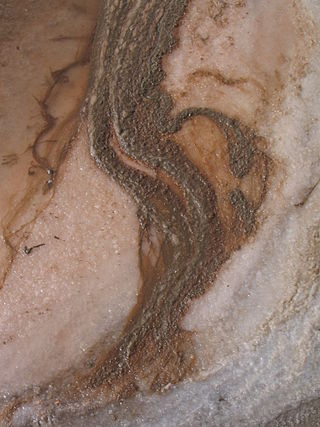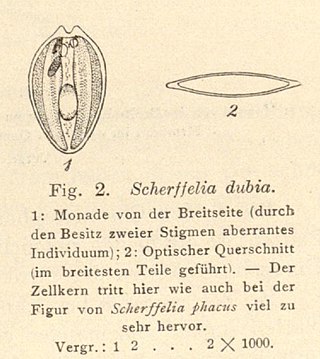Related Research Articles

The Noctilucales are an order of marine dinoflagellates. They differ from most others in that the mature cell is diploid and its nucleus does not show a dinokaryotic organization. They show gametic meiosis.
Cryptomonas is the name-giving genus of the Cryptomonads established by German biologist Christian Gottfried Ehrenberg in 1831. The algae are common in freshwater habitats and brackish water worldwide and often form blooms in greater depths of lakes. The cells are usually brownish or greenish in color and are characteristic of having a slit-like furrow at the anterior. They are not known to produce any toxins. They are used to feed small zooplankton, which is the food source for small fish in fish farms. Many species of Cryptomonas can only be identified by DNA sequencing. Cryptomonas can be found in several marine ecosystems in Australia and South Korea.

Yellow-green algae or the Xanthophyceae (xanthophytes) are an important group of heterokont algae. Most live in fresh water, but some are found in marine and soil habitats. They vary from single-celled flagellates to simple colonial and filamentous forms. Xanthophyte chloroplasts contain the photosynthetic pigments chlorophyll a, chlorophyll c, β-carotene, and the carotenoid diadinoxanthin. Unlike other Stramenopiles (heterokonts), their chloroplasts do not contain fucoxanthin, which accounts for their lighter colour. Their storage polysaccharide is chrysolaminarin. Xanthophyte cell walls are produced of cellulose and hemicellulose. They appear to be the closest relatives of the brown algae.
AFI's 100 Years...100 Stars is the American Film Institute's list ranking the top 25 male and 25 female greatest screen legends of American film history and is the second list of the AFI 100 Years... series.
The Minister of Transport is a cabinet member in the Government of France. The position was created in 1870 as a modification to the position of Minister of Public Works (1830–1870). It has frequently been combined with the position of Minister of Public Works, Minister of Housing (Logement), Minister of Tourism, Minister of Territorial Development, and Minister of the Sea
The Bayerisches Zuchtrennen is a Group 1 flat horse race in Germany open to thoroughbreds aged three years or older. It is run at Munich over a distance of 2,000 metres, and it is scheduled to take place each year on the last Sunday in July.

The cryptophyceae are a class of algae, most of which have plastids. About 230 species are known, and they are common in freshwater, and also occur in marine and brackish habitats. Each cell is around 10–50 μm in size and flattened in shape, with an anterior groove or pocket. At the edge of the pocket there are typically two slightly unequal flagella.

Dunaliellaceae is a family of algae in the order Chlamydomonadales.

Scherffelia is a genus of green algae in the family Chlorodendraceae.

Polyhymno is a genus of moths in the family Gelechiidae.

Dinophyceae is a class of dinoflagellates.

Rhodomonas is a genus of cryptomonads. It is characterized by its red colour, the square-shaped plates of its inner periplast, its short furrow ending in a gullet, and a distinctly shaped chloroplast closely associated with its nucleomorph. Historically, Rhodomonas was characterized by its red chloroplast alone, but this no longer occurs as its taxonomy has become increasingly based on molecular and cellular data. Currently, there is some debate about the taxonomic validity of Rhodomonas as a genus and further research is needed to verify its taxonomic status. Rhodomonas is typically found in marine environments, although freshwater reports exist. It is commonly used as a live feed for various aquaculture species.

The Pittsburgh City Council serves as the legislative body in the City of Pittsburgh. It consists of nine members. City council members are chosen by plurality elections in each of nine districts. The city operates under a mayor-council system of local governance.
Gilbert Morgan Smith was a botanist and phycologist, who worked primarily on the algae. He was best known for his books, particularly the Freshwater Algae of the United States, the Marine Algae of the Monterey Peninsula and the two volumes of Cryptogamic Botany.
Olpidiaceae is a fungal plant pathogen family of genera that was placed in the order Olpidiales.
Carl Friedrich Warnstorf was a German educator and bryologist specializing in Sphagnum studies.

Pyrenomonadaceae is a family of cryptomonads which includes three or four known genera. They are distinguished from other cryptomonads by their nucleomorphs being imbedded into the pyrenoid, and the presence of distinctive pigment phycoerythrin 545.
Rhinomonas fulva is a phytoplanktonic species of cryptomonad given its current designation in 1988.
References
- ↑ Pascher (1911), "Zwei braune Flagellaten", Berichte der Deutschen Botanischen Gesellschaft, 29: 190–192
- ↑ Pascher (1913), Die Süsswasser-Flora: Deutschlands, Österreichs und der Schweiz, vol. 2, pp. 99–114
- ↑ Butcher (1967), An Introductory Account of the Smaller Algae of British Coastal Waters.
- ↑ Hill and Wetherbee (1988), "The structure and taxonomy of Rhinomonas pauca gen. et sp. nov. (Cryptophyceae)", Phycologia, 27 (3): 355–365, doi:10.2216/i0031-8884-27-3-355.1